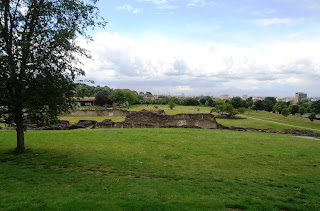We have spent our
last full day in London in a more relaxed fashion than the rest of the week, in
part as a concession to Chris’s gout reported on rising, but truth be told, it
has been good to have a more relaxed day.
The morning which
dawned gloriously fine, was spent juggling washing on my little line and
shopping at the Asda superstore in Belvedere, the suburb immediately east of
Abbey Wood. After lunch we set out to walk in the woods, those all around the
ruins of the Lesne Abbey giving Abbey Woods its name.
Lesne Abbey was
founded in 1178 by Richard de Luci, Chief Justiciar to Henry II. One year later
de Luci died and was buried in the Chapter House. During the twelfth century,
the Abbey came under the order of St Augustine (as opposed to Benedictine or
Cistercian).
The land belonging to
the Abbey included woods to the south-east and marshes to the north by the
river. The Abbey struggled financially throughout most of its existence, partly
due to the expense of maintaining the river walls and draining the marshes
along the banks of the Thames which regularly flooded. It gradually built up debts
and through the fourteenth century its buildings fell into disrepair.
The Abbey was closed around 1525 by Cardinal Wolsey, Henry VIII’s chief minister, and most of its monastic buildings were pulled down soon after the dissolution. Henry Cooke acquired the site in 1541, retaining the Abbot’s Lodging as a mansion house, but later it came into the possession of Sir John Hippersley, who dug it over for building materials, although the Abbot’s Lodging remained intact until it was demolished in 1845.
Today there remain only the base of the ruins, in the middle of a well mown lawn and adjacent gardens. Despite the intermittant showers that had arrived by now, this lower area was being enjoyed by picknicking families and those walking their dogs before settling down at the café for commercial refreshment.
From here we headed up the
hill into the woods where we encountered only one other walking party with
their dogs, a fox and dozens of squirrels scampering about the trees and
scuttling about the woodland path. This afternoon we discovered
that squirrels can be very vocal, in the same way honeyeaters are in banksia
bushes in Australia, their sound not too disimiliar.We decided this was truly a
wonderful spot and were so very glad we had bothered to explore the park next
door to our camp.



No comments:
Post a Comment